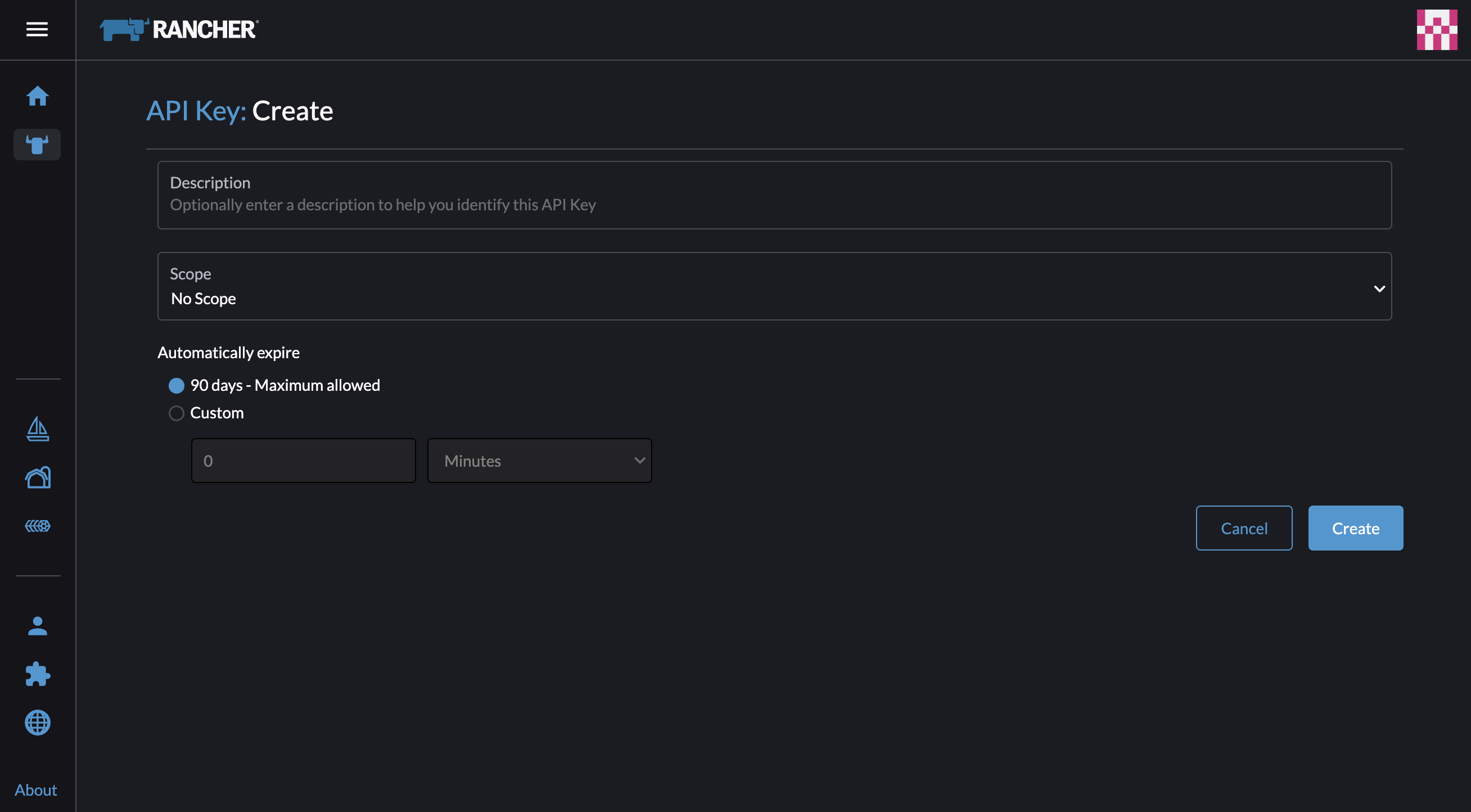Rancher Terraform
The Rancher Terraform Provider allows administrators to create and manage RKE2 guest clusters using Terraform.
Deployment
Prerequisites
- The Kubernetes cluster is built on top of Harvester VMs.
- The Harvester VMs that run as guest Kubernetes nodes are in the same namespace.
Deploy Guest Clusters Using the Rancher Terraform Provider
Create an API key.
On the Rancher UI, go to Account & API Keys > Create API key > Create.


Obtain the Harvester cluster ID.
On the Rancher UI, go to Virtualization Management > Manage > Related Resources > Mgmt Cluster Name.

Obtain the kubeconfig for the Harvester Cloud Provider and the Harvester CSI Driver.
- UI
- Shell
On the Rancher UI, go to Virtualization Management. Locate the target Harvester cluster in the list and then select ⋮ > Download KubeConfig.

# Generate harvester cloud provider kubeconfig
RANCHER_SERVER_URL="<RANCHER_SERVER_URL>" # Pure server URL like https://192.168.0.181:6443
RANCHER_ACCESS_KEY="<RANCHER_ACCESS_KEY>"
RANCHER_SECRET_KEY="<RANCHER_SECRET_KEY>"
HARVESTER_CLUSTER_ID="<HARVESTER_CLUSTER_ID>"
CLUSTER_NAME="rke2-demo"
curl -k -X POST ${RANCHER_SERVER_URL}/k8s/clusters/${HARVESTER_CLUSTER_ID}/v1/harvester/kubeconfig \
-H 'Content-Type: application/json' \
-u ${RANCHER_ACCESS_KEY}:${RANCHER_SECRET_KEY} \
-d '{"clusterRoleName": "harvesterhci.io:cloudprovider", "namespace": "default", "serviceAccountName": "'${CLUSTER_NAME}'"}' | xargs | sed 's/\\n/\n/g' > ${CLUSTER_NAME}-kubeconfigPrepare a
provider.tffile with the following content:terraform {
required_providers {
rancher2 = {
source = "rancher/rancher2"
version = "4.2.0"
}
}
}
# Configure the Rancher2 provider to admin
provider "rancher2" {
api_url = "<api_url>" # API Endpoint on Account & API Keys page
access_key = "<access_key>"
secret_key = "<secret_key>"
insecure = true # Set to true if the Rancher server uses a self-signed certificate
}Prepare a
main.tffile with the following content:# Get imported harvester cluster info
data "rancher2_cluster_v2" "harv" {
name = "<harvester_cluster_name_in_rancher>"
}
# Create a new Cloud Credential for an imported Harvester cluster
resource "rancher2_cloud_credential" "harv-cred" {
name = "harv-cred"
harvester_credential_config {
cluster_id = data.rancher2_cluster_v2.harv.cluster_v1_id
cluster_type = "imported"
kubeconfig_content = data.rancher2_cluster_v2.harv.kube_config
}
}
# Create a new rancher2 machine config v2 using harvester node_driver
resource "rancher2_machine_config_v2" "rke2-machine" {
generate_name = "rke2-machine"
harvester_config {
vm_namespace = "default"
cpu_count = "2"
memory_size = "4"
disk_info = <<EOF
{
"disks": [{
"imageName": "default/<vmimage-name>",
"size": 15,
"bootOrder": 1
}]
}
EOF
network_info = <<EOF
{
"interfaces": [{
"networkName": "default/<network-name>"
}]
}
EOF
ssh_user = "<ssh_user>"
user_data = <<EOF
package_update: true
packages:
- qemu-guest-agent
- iptables
runcmd:
- - systemctl
- enable
- '--now'
- qemu-guest-agent.service
EOF
}
}
resource "rancher2_cluster_v2" "rke2-demo" {
name = "rke2-demo"
kubernetes_version = "v1.28.10+rke2r1"
rke_config {
machine_pools {
name = "pool1"
cloud_credential_secret_name = rancher2_cloud_credential.harv-cred.id
control_plane_role = true
etcd_role = true
worker_role = true
quantity = 1
machine_config {
kind = rancher2_machine_config_v2.rke2-machine.kind
name = rancher2_machine_config_v2.rke2-machine.name
}
}
machine_selector_config {
config = yamlencode({
cloud-provider-config = file("${path.module}/rke2-demo-kubeconfig")
cloud-provider-name = "harvester"
})
}
machine_global_config = <<EOF
cni: "calico"
disable-kube-proxy: false
etcd-expose-metrics: false
EOF
upgrade_strategy {
control_plane_concurrency = "1"
worker_concurrency = "1"
}
etcd {
snapshot_schedule_cron = "0 */5 * * *"
snapshot_retention = 5
}
chart_values = <<EOF
harvester-cloud-provider:
clusterName: rke2-demo
cloudConfigPath: /var/lib/rancher/rke2/etc/config-files/cloud-provider-config
EOF
}
}Run
terraform init.Run
terraform apply.